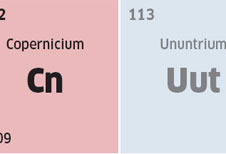They have existed for less than a second each, but two new elements have been added to the Periodic Table.
Click HERE to view graphic (53k jpg)
Evidence for the existence of the two elements, the heaviest yet to be included, has been mounting for several years. A number of research teams had claimed to have produced the heavy elements by smashing together the nuclei of lighter atoms. But it took a three-year review before they received official status.
The teams behind the discoveries will be invited to suggest names for the new elements, and unless particularly outlandish requests are made, they are likely to be accepted. An announcement is expected soon.
In the meantime, the International Union of Pure and Applied Chemistry (IUPAC) has assigned the elements the names ununquadium and ununhexium, derivations from their atomic numbers of 114 and 116, respectively.
Also considered were claims for discoveries of elements with the atomic number 113, 115 and 118 – but the report of the Joint Working Party for the Discovery of New Elements, made up of representatives from the Union of Applied Chemistry and the Union of Applied Physics, dismissed the evidence for these as not strong enough.
Heavy elements tend to be radioactive, as their atoms have many more neutrons than protons and so decay quickly. There would seem to be no practical use for an element which is stable for less than a second before decay, but it moves research closer to developing elements with 120 or more protons. Nuclear theorists think these super-heavy atoms might remain in a stable condition for several decades and exhibit useful chemical properties.
"The discovery moves us closer to the island of stability," said Dr Paul Karol, chairman of the joint working party. "Although 116 to 120 might seem like a small leap, it isn't. But once we get there everything should get easier again. These elements should exist for longer, so we can observe their chemical properties. No one knows if they will remain stable for a few minutes or years. They may be able to power nuclear reactors, or be useful for nuclear weapons. No one's sure – but you can always suspect the military will be interested."
Scientists have been unable to ascertain much about the properties of the new elements. "The quantities produced were very small and did not exist for very long," said Dr Karol. "Elements need to remain stable for almost a minute before much useful observation can be made of them."
Plutonium, with an atomic number of 94, is the heaviest naturally occurring element. All the elements heavier than this, including Einsteinium, Rutherfordium and Californium, have been produced synthetically and decay rather rapidly.
Dr Terry Renner, the executive director of IUPAC, said: "If you got to 120 or 126 you might get something with an infinite half life. If that was the case you could possibly manufacture compounds from the new materials that might be useful in computer technology and medicine. But no one really knows, and it's really all theoretical."
Subscribe to Independent Premium to bookmark this article
Want to bookmark your favourite articles and stories to read or reference later? Start your Independent Premium subscription today.


Join our commenting forum
Join thought-provoking conversations, follow other Independent readers and see their replies